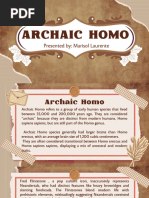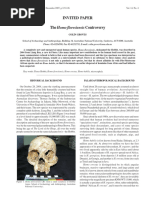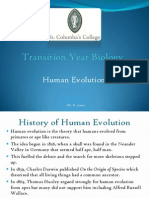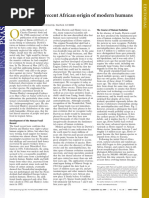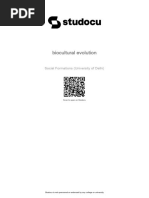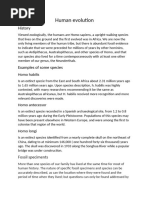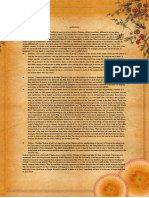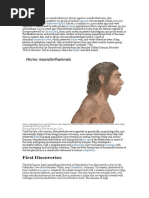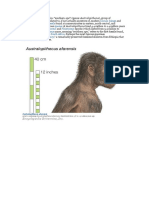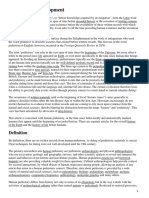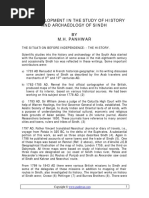0 ratings0% found this document useful (0 votes)
21 viewsSpecies Archaic Human Pleistocene Old World Iberian Peninsula Java Neanderthals Denisovans Modern Humans Chronospecies
Species Archaic Human Pleistocene Old World Iberian Peninsula Java Neanderthals Denisovans Modern Humans Chronospecies
Uploaded by
lisaHomo erectus was an early human species that lived from around 2 million years ago to around 117,000 years ago. H. erectus was the first human ancestor to spread throughout Africa and Eurasia. African populations of H. erectus likely gave rise to several later human species, while Asian populations may have been ancestral to Homo floresiensis and Homo luzonensis. H. erectus had human-like body proportions and was the first species to have a flat face and prominent nose. They made Acheulean stone tools and were capable of activities like hunting, gathering in groups, and possibly controlling fire.
Copyright:
© All Rights Reserved
Available Formats
Download as DOCX, PDF, TXT or read online from Scribd
Species Archaic Human Pleistocene Old World Iberian Peninsula Java Neanderthals Denisovans Modern Humans Chronospecies
Species Archaic Human Pleistocene Old World Iberian Peninsula Java Neanderthals Denisovans Modern Humans Chronospecies
Uploaded by
lisa0 ratings0% found this document useful (0 votes)
21 views1 pageHomo erectus was an early human species that lived from around 2 million years ago to around 117,000 years ago. H. erectus was the first human ancestor to spread throughout Africa and Eurasia. African populations of H. erectus likely gave rise to several later human species, while Asian populations may have been ancestral to Homo floresiensis and Homo luzonensis. H. erectus had human-like body proportions and was the first species to have a flat face and prominent nose. They made Acheulean stone tools and were capable of activities like hunting, gathering in groups, and possibly controlling fire.
Original Description:
mvmvhig
Original Title
Homo Erectus
Copyright
© © All Rights Reserved
Available Formats
DOCX, PDF, TXT or read online from Scribd
Share this document
Did you find this document useful?
Is this content inappropriate?
Homo erectus was an early human species that lived from around 2 million years ago to around 117,000 years ago. H. erectus was the first human ancestor to spread throughout Africa and Eurasia. African populations of H. erectus likely gave rise to several later human species, while Asian populations may have been ancestral to Homo floresiensis and Homo luzonensis. H. erectus had human-like body proportions and was the first species to have a flat face and prominent nose. They made Acheulean stone tools and were capable of activities like hunting, gathering in groups, and possibly controlling fire.
Copyright:
© All Rights Reserved
Available Formats
Download as DOCX, PDF, TXT or read online from Scribd
Download as docx, pdf, or txt
0 ratings0% found this document useful (0 votes)
21 views1 pageSpecies Archaic Human Pleistocene Old World Iberian Peninsula Java Neanderthals Denisovans Modern Humans Chronospecies
Species Archaic Human Pleistocene Old World Iberian Peninsula Java Neanderthals Denisovans Modern Humans Chronospecies
Uploaded by
lisaHomo erectus was an early human species that lived from around 2 million years ago to around 117,000 years ago. H. erectus was the first human ancestor to spread throughout Africa and Eurasia. African populations of H. erectus likely gave rise to several later human species, while Asian populations may have been ancestral to Homo floresiensis and Homo luzonensis. H. erectus had human-like body proportions and was the first species to have a flat face and prominent nose. They made Acheulean stone tools and were capable of activities like hunting, gathering in groups, and possibly controlling fire.
Copyright:
© All Rights Reserved
Available Formats
Download as DOCX, PDF, TXT or read online from Scribd
Download as docx, pdf, or txt
You are on page 1of 1
Homo erectus
(meaning "upright man") is an extinct species of archaic human from
the Pleistocene, with its earliest occurrence about 2 million years ago,[2] and its specimens are
among the first recognisable members of the genus Homo. H. erectus was the first human
ancestor to spread throughout the Old World, having a distribution in Eurasia extending from
the Iberian Peninsula to Java. African populations of H. erectus are likely to be the ancestors to
several human species, such as H. heidelbergensis and H. antecessor, with the former generally
considered to have been the ancestor to Neanderthals and Denisovans, and sometimes
also modern humans.[3][4][5] Asian populations of H. erectus may be ancestral to H.
floresiensis[6] and possibly to H. luzonensis.[7] As a chronospecies, the time of the disappearance
of H. erectus is a matter of contention. There are also several proposed subspecies with varying
levels of recognition. The last known record of morphologically recognisable H. erectus are
the Solo Man specimens from Java, around 117–108,000 years ago.[1]
H. erectus had a humanlike gait and body proportions, and was the first human species to have
exhibited a flat face, prominent nose, and possibly sparse body hair coverage. Though brain size
certainly exceeds that of ancestor species, capacity varied widely depending on the population. In
older populations, brain development seemed to cease early in childhood, suggesting that
offspring were largely self-sufficient at birth, thus limiting cognitive development through life.
Nonetheless, sites generally show consumption of medium to large animals, such
as bovines or elephants, and suggest the development of predatory behaviour and coordinated
hunting. H. erectus is associated with the Acheulean stone tool industry, and is postulated to have
been the earliest human ancestor capable of using fire, hunting and gathering in coordinated
groups, caring for injured or sick group members, and possibly seafaring and art (though examples
of art are controversial, and are otherwise rudimentary and few and far between).
H. erectus men and women may have been roughly the same size as each other (i.e. exhibited
reduced sexual dimorphism) like modern humans, which could indicate monogamy in line with
general trends exhibited in primates. Size, nonetheless, ranged widely from 146–185 cm (4 ft 9 in–
6 ft 1 in) in height and 40–68 kg (88–150 lb) in weight. It is unclear if H. erectus was anatomically
capable of speech, though it is postulated they communicated using some proto-language.
You might also like
- Investigatory ProjectDocument21 pagesInvestigatory ProjectDiya 2788% (93)
- Unit 1 - Introduction To Technology For Teaching and LearningDocument3 pagesUnit 1 - Introduction To Technology For Teaching and Learninglisa78% (9)
- Japan To 1600 PDFDocument248 pagesJapan To 1600 PDFJuan Manuel Orozco Henao100% (6)
- Allen McCartney, Douglas Veltre Auth., Peter N. Peregrine, Melvin Ember Eds. Encyclopedia of Prehistory Volume 2 Arctic and Subarctic PDFDocument272 pagesAllen McCartney, Douglas Veltre Auth., Peter N. Peregrine, Melvin Ember Eds. Encyclopedia of Prehistory Volume 2 Arctic and Subarctic PDFHugoBotelloNo ratings yet
- 50 Art Ideas You Really Need To KnowDocument199 pages50 Art Ideas You Really Need To KnowMichel RojasNo ratings yet
- Gardner's Art Through The Ages, 12eDocument32 pagesGardner's Art Through The Ages, 12exmelodyx5345345No ratings yet
- Homo ErectusDocument27 pagesHomo ErectusPlanet CscNo ratings yet
- Evolucion HDocument7 pagesEvolucion HAmygaty Escobar ParedesNo ratings yet
- EvolutionDocument4 pagesEvolutionDiana Tomas SalvadorNo ratings yet
- ARDocument13 pagesARRilyNo ratings yet
- Luxury Hotels KutaDocument4 pagesLuxury Hotels KutaEdithya EffendiNo ratings yet
- G1 AustralopithecusandHomoerectus 206239472350308Document6 pagesG1 AustralopithecusandHomoerectus 206239472350308john TabonNo ratings yet
- Human EvolutionDocument9 pagesHuman EvolutionAndrew JonesNo ratings yet
- Human EvolutionDocument9 pagesHuman EvolutionVinod BhaskarNo ratings yet
- Archaic Humans: HistoricallyDocument4 pagesArchaic Humans: HistoricallyBenali Alaa EddineNo ratings yet
- FDF '''''''' (J Hgyghuman Evolution: Homo HabilisDocument19 pagesFDF '''''''' (J Hgyghuman Evolution: Homo HabilisRalph MaglasangNo ratings yet
- Archaic HomoDocument12 pagesArchaic HomoJussel Catalo IINo ratings yet
- Infos Ape To ManDocument8 pagesInfos Ape To Manjosh salahidNo ratings yet
- Biological Evolution of Early Humans and Modern HumansDocument23 pagesBiological Evolution of Early Humans and Modern HumansNikkiItliong100% (1)
- Human Evolution: Mr. H. JonesDocument23 pagesHuman Evolution: Mr. H. Jonessccscience100% (1)
- Biological Evolution of Early Humans and Modern Humans: Understanding Culture, Society and PoliticsDocument24 pagesBiological Evolution of Early Humans and Modern Humans: Understanding Culture, Society and PoliticsJansenn PastorNo ratings yet
- Human Evolution 7Document5 pagesHuman Evolution 7Sanket PatilNo ratings yet
- Mar 5 2018Document1 pageMar 5 2018chungman.blNo ratings yet
- Report in Maam Princess SubDocument33 pagesReport in Maam Princess SubrubiasandramaeNo ratings yet
- Human EvoDocument13 pagesHuman EvomahinnilavanNo ratings yet
- Man and His OriginDocument16 pagesMan and His OriginUduebor MichealNo ratings yet
- Anth Project PWeeksDocument18 pagesAnth Project PWeekspjf_weeksNo ratings yet
- Biological and Cultural EvolutionDocument55 pagesBiological and Cultural EvolutionKarl Rigo Andrino100% (3)
- evolution of humansDocument9 pagesevolution of humansDharssan DharshikaNo ratings yet
- Script 2Document3 pagesScript 2miah.palo97No ratings yet
- EvolutionDocument19 pagesEvolutionaafilaabdul13No ratings yet
- About Homo SapiensDocument9 pagesAbout Homo Sapiensearly yearlyNo ratings yet
- Human Evolution DissertationDocument4 pagesHuman Evolution DissertationPapersWritingHelpSingapore100% (2)
- Homo Homo Sapiens: Human Evolution Is TheDocument2 pagesHomo Homo Sapiens: Human Evolution Is TheSanket PatilNo ratings yet
- Bushes and Ladders in Human Evolution-1Document5 pagesBushes and Ladders in Human Evolution-1KateTackettNo ratings yet
- Written Report For Ucsp: Biological and Cultural Evolution: From Australopithecus To Homo SapiensDocument10 pagesWritten Report For Ucsp: Biological and Cultural Evolution: From Australopithecus To Homo SapiensJustin Raton ManingoNo ratings yet
- Homo Erectus and Homo Sapiens: Physical Differences, Cultural SimilaritiesDocument3 pagesHomo Erectus and Homo Sapiens: Physical Differences, Cultural Similaritiesmassnerder100% (3)
- Australopiticus and Homo HabilisDocument17 pagesAustralopiticus and Homo HabilisThea SprouseNo ratings yet
- The Non-Transitions in Human Evolution - On Evolutionists TeDocument6 pagesThe Non-Transitions in Human Evolution - On Evolutionists TepilesarNo ratings yet
- Hobbit - Homo FloresiensisDocument9 pagesHobbit - Homo FloresiensisKiichi13No ratings yet
- Klein2009-African Origin of Modern HumansDocument3 pagesKlein2009-African Origin of Modern HumansGiulia AndreeaNo ratings yet
- Stages of Human EvolutionDocument4 pagesStages of Human EvolutionMehwishNo ratings yet
- Module 1 Cont.Document23 pagesModule 1 Cont.Bianka SylveeNo ratings yet
- Evolution of MankindDocument8 pagesEvolution of MankindPrecious Renzlyn CadionNo ratings yet
- Vertebrate PalaeontologyDocument6 pagesVertebrate Palaeontologyosloline4No ratings yet
- Evidence From The Fossil RecordDocument2 pagesEvidence From The Fossil Recordnikita bajpaiNo ratings yet
- Homo HabilisDocument5 pagesHomo HabilisJay R ChivaNo ratings yet
- interplay 1111Document9 pagesinterplay 1111ayarachoudhary144No ratings yet
- Homo ErgasterDocument7 pagesHomo Ergasterjoel lopezNo ratings yet
- Evolution of GenusDocument2 pagesEvolution of Genusnikita bajpaiNo ratings yet
- 443047265-INVESTIGATORY-PROJECT (1)_removedDocument18 pages443047265-INVESTIGATORY-PROJECT (1)_removedkishoretvis3No ratings yet
- Evolution of HumanDocument11 pagesEvolution of HumansanandresmariannekayeNo ratings yet
- Biological and Cultural EvolutionDocument35 pagesBiological and Cultural Evolutionrizalyn alegre0% (1)
- Origin and Evolution of ManDocument3 pagesOrigin and Evolution of ManScribdTranslationsNo ratings yet
- Cloning Humans? Biological, Ethical, and Social ConsiderationsDocument8 pagesCloning Humans? Biological, Ethical, and Social ConsiderationsPuput Anistiya HarianiNo ratings yet
- Evolution of HumansDocument9 pagesEvolution of HumansZwe Wai YanNo ratings yet
- EvolutionDocument16 pagesEvolutionAagash PranavNo ratings yet
- The Family Tree of ManDocument5 pagesThe Family Tree of ManElisha Gine AndalesNo ratings yet
- Homo HabilisDocument2 pagesHomo HabilisNitesh KotianNo ratings yet
- Hominid Species: Ardipithecus RamidusDocument5 pagesHominid Species: Ardipithecus RamidusJondelle YlaganNo ratings yet
- Documento 3Document2 pagesDocumento 3Mentxu González PerezNo ratings yet
- SkullsDocument17 pagesSkullsBart FosterNo ratings yet
- About the Little People: Fairies, Elves, Dwarfs, and LeprechaunsFrom EverandAbout the Little People: Fairies, Elves, Dwarfs, and LeprechaunsNo ratings yet
- The Concept of LCPDocument7 pagesThe Concept of LCPlisaNo ratings yet
- Angelica E. Aguirre Bse 1 - Fil 1 Activity 8: Girl Boy Bakla TomboyDocument1 pageAngelica E. Aguirre Bse 1 - Fil 1 Activity 8: Girl Boy Bakla TomboylisaNo ratings yet
- Educ85 Week2Document26 pagesEduc85 Week2lisaNo ratings yet
- P.D. 603 - The Child and Youth Welfare CodeDocument1 pageP.D. 603 - The Child and Youth Welfare CodelisaNo ratings yet
- Self PresentationDocument3 pagesSelf PresentationlisaNo ratings yet
- Lesson: Cognitive Processes (Constructivism, Bloom's Taxonomy of Educational ObjectivesDocument9 pagesLesson: Cognitive Processes (Constructivism, Bloom's Taxonomy of Educational ObjectiveslisaNo ratings yet
- Educ85 Week4Document19 pagesEduc85 Week4lisaNo ratings yet
- Aguirre - Bse1 Fil1 Activity 4 Reaction PaperDocument1 pageAguirre - Bse1 Fil1 Activity 4 Reaction PaperlisaNo ratings yet
- Sexual SelfDocument3 pagesSexual SelflisaNo ratings yet
- First Discoveries: Neanderthal, (Homo Neanderthalensis, Homo Sapiens Neanderthalensis), AlsoDocument3 pagesFirst Discoveries: Neanderthal, (Homo Neanderthalensis, Homo Sapiens Neanderthalensis), AlsolisaNo ratings yet
- Primates Human Beings Fossils Africa Species Pliocene Pleistocene Genus South Africa LucyDocument5 pagesPrimates Human Beings Fossils Africa Species Pliocene Pleistocene Genus South Africa LucylisaNo ratings yet
- CometsDocument1 pageCometslisaNo ratings yet
- Australopithecus Afarensis Is AnDocument1 pageAustralopithecus Afarensis Is AnlisaNo ratings yet
- Homo Sapiens, (Latin: "Wise Man") The: Species Human Beings Homo Extinct Human EvolutionDocument6 pagesHomo Sapiens, (Latin: "Wise Man") The: Species Human Beings Homo Extinct Human EvolutionlisaNo ratings yet
- The Cerebrum Is Divided Into Two Major PartsDocument4 pagesThe Cerebrum Is Divided Into Two Major PartslisaNo ratings yet
- The Nature of Reactants Is Different From The OtheDocument1 pageThe Nature of Reactants Is Different From The OthelisaNo ratings yet
- Istoria An de An - Civilizatia Antica La Ce-A Medievala PDFDocument164 pagesIstoria An de An - Civilizatia Antica La Ce-A Medievala PDFVladimirov0% (1)
- A Re-Examination of Variability in Handaxe Form in The British PalaeolithicDocument403 pagesA Re-Examination of Variability in Handaxe Form in The British PalaeolithicChandan Kumar RoyNo ratings yet
- By Ld-Complete Illustrated Encyclopedia of Symbols, Signs Dream Interpretation (Mark OConnell, Richard Craze, Raje Airey) ?Document520 pagesBy Ld-Complete Illustrated Encyclopedia of Symbols, Signs Dream Interpretation (Mark OConnell, Richard Craze, Raje Airey) ?Madalena QuerCasarNo ratings yet
- Prehistoric Art (Stone Age)Document46 pagesPrehistoric Art (Stone Age)Ajay KumarNo ratings yet
- Rod 2Document2 pagesRod 2marianne moralesNo ratings yet
- Contemporary Philippine Arts From The RegionsDocument28 pagesContemporary Philippine Arts From The RegionsCHRISTY BUTIALNo ratings yet
- Lesson 2. Science and Technology During Pre Historic TimesDocument8 pagesLesson 2. Science and Technology During Pre Historic TimesKing HarlequinNo ratings yet
- Introducing Indian Prehistory PappuDocument8 pagesIntroducing Indian Prehistory Pappuamita gupta100% (1)
- Ch1 Lesson 1 UpdatedDocument9 pagesCh1 Lesson 1 UpdatedJudy Fe Bay-anNo ratings yet
- David Wengrow and David Graeber, Farewell To The "Childhood of Man": Ritual, Seasonality, and The Origins of Inequality', Journal of The Royal Anthropological Institute, 2015 .Document23 pagesDavid Wengrow and David Graeber, Farewell To The "Childhood of Man": Ritual, Seasonality, and The Origins of Inequality', Journal of The Royal Anthropological Institute, 2015 .OSGuinea100% (1)
- History For 9th GradeDocument75 pagesHistory For 9th GradeMichael RodionNo ratings yet
- Sponsel - 96 - The Natural History of PeaceDocument31 pagesSponsel - 96 - The Natural History of PeaceHeather WoodNo ratings yet
- UntitledDocument102 pagesUntitledHarsh GautamNo ratings yet
- Tints Are Values Above The Normal Shades Are Values Below The NormalDocument4 pagesTints Are Values Above The Normal Shades Are Values Below The NormalAngelika Merce OngNo ratings yet
- 1st Periodical Exam in Understanding Culture Society and Politics ReviewerDocument15 pages1st Periodical Exam in Understanding Culture Society and Politics ReviewerophelialeighdumpNo ratings yet
- Shelter The Old Stone Age The Middle Stone Age The New Stone AgeDocument3 pagesShelter The Old Stone Age The Middle Stone Age The New Stone Ageanon_547056234No ratings yet
- Stone, Bronz, Iron Ages - Reading 2Document7 pagesStone, Bronz, Iron Ages - Reading 2Kaye ReiesNo ratings yet
- 22 Larsson and MolinDocument39 pages22 Larsson and MolinBobi BobiNo ratings yet
- Fundamentals of AgronomyDocument196 pagesFundamentals of Agronomykatholevaishnavi15No ratings yet
- Article 116Document52 pagesArticle 116balochimrankhanNo ratings yet
- Upper PalaeolithicDocument6 pagesUpper Palaeolithicswaraj kumarNo ratings yet
- Ehret, C. Early Humans: Tools, Language, and CultureDocument23 pagesEhret, C. Early Humans: Tools, Language, and CultureHenrique Espada LimaNo ratings yet
- Ucsp 1ST QTRDocument31 pagesUcsp 1ST QTRJohnArgielLaurenteVictorNo ratings yet
- Gudiyam CaveDocument6 pagesGudiyam CavenochiNo ratings yet
- Study Material - Unit -8 (Eng)Document132 pagesStudy Material - Unit -8 (Eng)vinothinichinnadurairNo ratings yet
- HoA PrehistoryDocument22 pagesHoA PrehistorymielNo ratings yet









